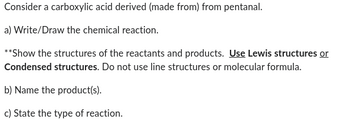
Chemistry
10th Edition
ISBN: 9781305957404
Author: Steven S. Zumdahl, Susan A. Zumdahl, Donald J. DeCoste
Publisher: Cengage Learning
expand_more
expand_more
format_list_bulleted
Question

Transcribed Image Text:Consider a carboxylic acid derived (made from) from pentanal.
a) Write/Draw the chemical reaction.
**Show the structures of the reactants and products. Use Lewis structures or
Condensed structures. Do not use line structures or molecular formula.
b) Name the product(s).
c) State the type of reaction.
Expert Solution
This question has been solved!
Explore an expertly crafted, step-by-step solution for a thorough understanding of key concepts.
Step by stepSolved in 3 steps with 7 images

Follow-up Questions
Read through expert solutions to related follow-up questions below.
Follow-up Question
I asked for the answer to be in lewis structure or condensed structure can you fix it.
Solution
by Bartleby Expert
Follow-up Questions
Read through expert solutions to related follow-up questions below.
Follow-up Question
I asked for the answer to be in lewis structure or condensed structure can you fix it.
Solution
by Bartleby Expert
Knowledge Booster
Learn more about
Need a deep-dive on the concept behind this application? Look no further. Learn more about this topic, chemistry and related others by exploring similar questions and additional content below.Similar questions
- Consider the structures of salicylic acid and acetylsalicylic acid. What functional groups do both molecules have in common? What functional groups is/are different?arrow_forwardHow can you tell from the name the types of bonds present in a hydrocarbon?arrow_forwardThe average bond enthalpy for C-His 413 kJ/mol. 413 kJ of energy is required to break a mole of CH into atoms: CH(g)→C(g) + H(g), AH=413 kJ Using this information, and your answer from Part A, calculate the enthalpy change of the reaction from Part B. That is, calculate the energy required to break only the carbon-carbon bonds in benzene. Express your answer to four significant figures and include the appropriate units. > View Available Hint(s) HA AHrxn = Value Units Submit Part D Complete previous part(s) Next > Provide Feedback 9:33 PM B. W Word Google .. Spotify .. 61°F 11/17/2021arrow_forward
- Draw the formula for this carboxylic acidarrow_forwardDraw the skeletal structure of a 3º alkyl fluoride with six carbon atoms and no rings. Click and drag to start drawing a structure.arrow_forwardYou are given propane and hexanoic acid. Your job is to create the ester isopropyl hexanoate. Use the correct chemical reactions in order to get the products needed to create the ester, assume if there are multiple isomers that you are able to isolate the isomer you need.arrow_forward
- What are "common names" of organic molecules? How do those rules change if we substitute some of the hydrogen atoms with , for example , chlorine atoms ?arrow_forward:) Fill in the blanks with the NAME and STRUCTURE of the ORGANIC REACTANT or the NAME and STRUCTURE of the MAJOR ORGANIC PRODUCT in the following reactions:arrow_forwardWrite the word equation for the reaction of pentanoic acid and ethyl alcohol. Give all reactants and products.arrow_forward
- 1. Use condensed structural formulas to write the equation for the formation of methyl acetate. 2. Alcohol and Carboxylic 3. Odor of Ester 4. Condensed Structural Acid Formula and Name of Ester A. Methanol and salicylic acid B. 1-Pentanol and acetic acid C. 1-Octanol and acetic acid D. Benzyl alcohol and acetic acid E. 1-Propanol and acetic acidarrow_forwardDraw the structural formula for n-pentane and an isomer of it. Name the isomer.arrow_forwardWhat is your understanding of the term organic now ? Describe the connection you see between the various definitions?arrow_forward
arrow_back_ios
SEE MORE QUESTIONS
arrow_forward_ios
Recommended textbooks for you
 ChemistryChemistryISBN:9781305957404Author:Steven S. Zumdahl, Susan A. Zumdahl, Donald J. DeCostePublisher:Cengage Learning
ChemistryChemistryISBN:9781305957404Author:Steven S. Zumdahl, Susan A. Zumdahl, Donald J. DeCostePublisher:Cengage Learning ChemistryChemistryISBN:9781259911156Author:Raymond Chang Dr., Jason Overby ProfessorPublisher:McGraw-Hill Education
ChemistryChemistryISBN:9781259911156Author:Raymond Chang Dr., Jason Overby ProfessorPublisher:McGraw-Hill Education Principles of Instrumental AnalysisChemistryISBN:9781305577213Author:Douglas A. Skoog, F. James Holler, Stanley R. CrouchPublisher:Cengage Learning
Principles of Instrumental AnalysisChemistryISBN:9781305577213Author:Douglas A. Skoog, F. James Holler, Stanley R. CrouchPublisher:Cengage Learning Organic ChemistryChemistryISBN:9780078021558Author:Janice Gorzynski Smith Dr.Publisher:McGraw-Hill Education
Organic ChemistryChemistryISBN:9780078021558Author:Janice Gorzynski Smith Dr.Publisher:McGraw-Hill Education Chemistry: Principles and ReactionsChemistryISBN:9781305079373Author:William L. Masterton, Cecile N. HurleyPublisher:Cengage Learning
Chemistry: Principles and ReactionsChemistryISBN:9781305079373Author:William L. Masterton, Cecile N. HurleyPublisher:Cengage Learning Elementary Principles of Chemical Processes, Bind...ChemistryISBN:9781118431221Author:Richard M. Felder, Ronald W. Rousseau, Lisa G. BullardPublisher:WILEY
Elementary Principles of Chemical Processes, Bind...ChemistryISBN:9781118431221Author:Richard M. Felder, Ronald W. Rousseau, Lisa G. BullardPublisher:WILEY

Chemistry
Chemistry
ISBN:9781305957404
Author:Steven S. Zumdahl, Susan A. Zumdahl, Donald J. DeCoste
Publisher:Cengage Learning

Chemistry
Chemistry
ISBN:9781259911156
Author:Raymond Chang Dr., Jason Overby Professor
Publisher:McGraw-Hill Education

Principles of Instrumental Analysis
Chemistry
ISBN:9781305577213
Author:Douglas A. Skoog, F. James Holler, Stanley R. Crouch
Publisher:Cengage Learning

Organic Chemistry
Chemistry
ISBN:9780078021558
Author:Janice Gorzynski Smith Dr.
Publisher:McGraw-Hill Education

Chemistry: Principles and Reactions
Chemistry
ISBN:9781305079373
Author:William L. Masterton, Cecile N. Hurley
Publisher:Cengage Learning

Elementary Principles of Chemical Processes, Bind...
Chemistry
ISBN:9781118431221
Author:Richard M. Felder, Ronald W. Rousseau, Lisa G. Bullard
Publisher:WILEY